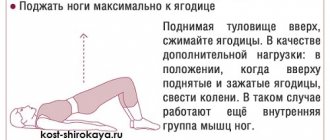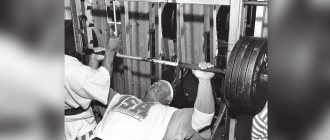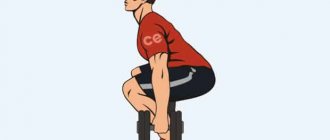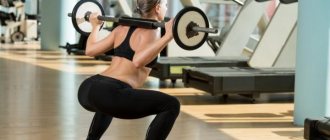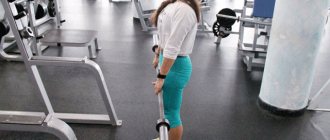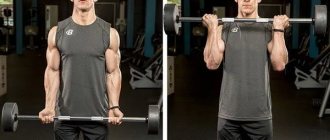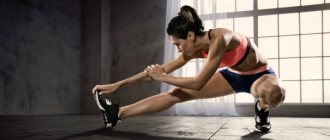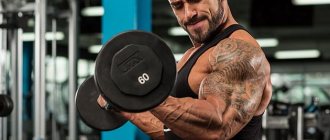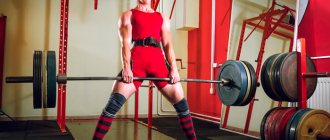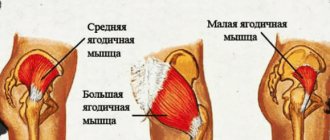The benefits of lunges
The popularity of the exercise is due to many advantages:
- Development of power characteristics . Lunges with additional weights are used in strength training as a way to specifically target the hips.
- Relief improvement . Quick lunges with your own weight or minimal loads help to achieve high-quality “detailing” of the leg muscles.
- Development of coordination . Thanks to the simultaneous development of several stabilizer muscles, the athlete improves his sense of balance and dexterity.
- Strengthening problem areas . Girls use lunges to work their inner thighs, improving the appearance of their legs.
- Losing weight . The exercise simultaneously uses large muscles of the body, which forces the body to spend a large number of calories to provide energy.
- Butt training . By changing the exercise technique, an athlete can shift the emphasis of the load from the hips to the buttocks, achieving an increase in their volume.
- Stretching . Thanks to deep lunges in different directions, the athlete gets the opportunity to improve leg stretching and hip joint mobility.
In addition to the above, classic lunges with your own weight can be an excellent replacement for squats with a barbell if you have problems with the spine.
Contraindications for implementation
Those who have never done gymnastic exercises should carefully approach lunges. They are traumatic exercises, so in the first stages it is advisable to perform them under the supervision of an instructor. He will give the necessary recommendations and help you correctly calculate the load, the number of approaches and help reduce the risk of injury.
Or you can start with safer exercises like bodyweight squats or glute bridges.
Contraindications to performing lunges are high blood pressure, some joint diseases, and incompletely treated injuries. It is better to first consult a doctor, and then boldly begin the exercises.
Lunges forward and backward
The most popular variation of the exercise is the classic forward lunge. They are used by both professional athletes and beginners. Technique:
- We stand up straight and press our hands to our belts.
- Inhale, step forward and simultaneously lower your pelvis.
- In the lower position, the knee joints of both legs should be at an angle of 90°.
- We hold for a couple of seconds, and then, with an exhalation, we also smoothly return to the vertical position.
- We repeat the exercise starting with the other leg.
At first you will be a little wobbly. Therefore, until the muscles become stronger, perform lunges without additional weights.
If you have difficulty maintaining your balance, we recommend using a Smith machine. The lunge technique in this machine is as follows:
- We stand in the machine, remove the sliding bar from the stops and press it against the trapezius muscle (upper back).
- We put one leg forward and take the other back. The distance between the feet should be approximately 60–70 cm.
- Inhaling, we smoothly lower ourselves to a right angle at the “front” knee.
- We hold for a couple of seconds, and then, exhaling, we also smoothly return to the starting position.
- We do 10-12 squats, change legs and repeat.
The bar is secured to the rails so you can squat safely into a lunge while strengthening your thigh muscles.
If you experience pain in the knee joint, replace classic lunges with reverse lunges. The only difference is in the technique: the leg is not moved forward, but backward.
Once you have mastered simple and reverse lunges without weight, gradually add weights. Start with light dumbbells in each hand (2-3 kg) or small weights. If you are confident in your abilities, perform the exercise with an empty bar on your shoulders.
General recommendations for the considered variations:
- do not slouch or round your back;
- do not extend your front knee further than your toes;
- Turn the toe of the “back” leg slightly inward;
- in any variation, do not place the “back” knee on the floor;
- do not lean forward too much;
- keep your head straight;
- If you can’t maintain balance, grab a support with one hand.
Additional burden
Dumbbells, a ball with sand, or a barbell with or without weights can be used as additional weights. Dumbbells are held one in each hand. The barbell can be held on the shoulders behind the head. To transfer the main load to the quadriceps, it is possible to hold the barbell also on the shoulders, but in front of the head. The ball with sand is held in arms straightened forward.
These options have their own disadvantages and advantages. It is easier to hold a barbell on the shoulders, but this increases the load on the spine, and with dumbbells it is easier to maintain balance, but when using large weights, the muscles of the forearms and wrist joint are overloaded. A sand ball overloads your arm muscles. Difficulty maintaining balance.
Lunges using a platform
First, let's look at the “Bulgarian” lunges. The variation involves the use of a high support for the hind leg. Technique:
- We stand with our backs to the bench.
- Take a wide step with your right foot. The distance between the feet is 70–80 cm.
- Raise your left leg and place its toe in the seat.
- Cross your forearms at chest level.
- As you inhale, smoothly lower your body as low as possible (for beginners, it is acceptable to squat to a right angle at the “front” knee).
- We hold for a second, then, as we exhale, we rise just as smoothly.
By lifting the “back” foot high, the body’s weight is essentially shifted to the “front” foot, which increases the load on the quadriceps, glutes and hamstrings.
Recommendations:
- Press your “working” foot into your heel;
- do not extend your knee further than your foot;
- Having risen, do not straighten the knee joint completely;
- do not rest in the upper phase;
- keep your lower back arched;
- To increase the load, use a fitness ball or TRX loops instead of a solid support.
Now let's look at another option for using platforms. Using a low stand, you can perform wide lunges for the buttocks. The technique is simple:
- We select a low platform (15–20 cm). We take dumbbells in our hands and stand on the stand.
- Keeping your back straight, inhale, move your right leg back as far as possible and place its toe on the floor.
- In the lower phase, we linger for a second, and then, as we exhale, we smoothly return to the starting position.
- Repeat with the left leg.
In this exercise, the muscles of the buttocks work more efficiently than with conventional reverse lunges, since due to the lifting of the supporting foot, the stretching of the entire back surface of the thigh increases.
Recommendations:
- when abducting the “back” leg, keep the “front” shin vertical;
- slightly tilt your body forward, but do not round your back;
- do not perform the element from a high platform (for example, from a bench), it can be dangerous.
The most effective lunges for the buttocks - a technique to perform at home
This movement is used to strengthen the buttocks and legs. It is known from history that this type of exercise was used in ancient Rome to develop strong muscles in warriors.
Lunges can be long or short: when doing long lunges, we work the buttocks, and when doing short lunges, we put stress on the thigh muscles. These exercises are very effective for tightening the gluteal muscles and contribute to the formation of their beautiful shape.
The exercise “lunges for the buttocks” at home is one of the best of its kind, second only to squats with dumbbells. With regular use, it gives an excellent effect on the “fifth point”. In order to understand why they give such results, let's consider which muscles work when performing these movements.
Side lunges
The exercise allows you to well load the outer side of the quadriceps and buttocks. In addition, the inner thighs are strengthened and leg stretching is improved. Let's start with a simple technique for beginner athletes:
- We stand up straight and spread our feet wide (80–100 cm). We put our hands on our waists.
- As we inhale, we shift our body weight to the side and move our pelvis back, as if we were sitting down on an imaginary chair.
- As you exhale, we return to the starting position.
- Repeat on the other side.
The exercise can be performed with weights, for example, with a body bar on your shoulders.
Let's look at a slightly more complicated version of side lunges:
- We stand up straight and place our feet the width of our pelvic bones.
- Inhale and take a step to the side.
- At the same time, we move the pelvic region back.
- As you exhale, we return to the vertical position.
- We perform in the opposite direction.
Recommendations for the presented exercise options:
- do not extend the knee joint beyond the foot;
- slightly tilt your body forward;
- at the lowest point, take a slight pause;
- if you want to make it more challenging, hold a dumbbell in each hand or perform side lunges from a step platform.
Analysis of the exercise
What muscles work
This is a complex multi-joint movement. The load falls mainly on the front and back of the thigh and buttocks. The torso muscles work as stabilizers, as do the core muscles. Hands hold dumbbells or a barbell and work statically.
The load is distributed between:
- Biceps femoris;
- Buttocks;
- Calf;
- Press;
- Soleus;
- Iliopsoas;
- Arm muscles as weight stabilizers
Preparing for the exercise
The movement is difficult to coordinate. Before starting the exercise, you need to actively warm up the muscles, and no less actively carry out a special warm-up. It means flexion and extension at the knee and hip joints, dynamic calf stretching (bending against the wall) and several sets of back lunges without weight. Some trainers give their trainees back lunges in Smith as a warm-up so that the person actively fills the muscles with blood.
The exercise should start with light weights, gradually progressing to the working weight. Usually a step of 10 kg is enough.
Beginners can do this movement with small dumbbells or a bar, then warming up on the floor is enough. Those who continue can perform the exercise with heavier weights. Everyone needs to check the flooring to make sure their feet don't slip.
How to do it right
- Bending the knee at an acute angle is not allowed. It is necessary to position the foot so that the shin is perpendicular to the floor and the knee does not bend at an acute angle;
- What matters is how stable the shoulder girdle is. The tilt of the body depends on the stability of the shoulder girdle, so you need to tense your back and move your shoulders away from your ears;
- The step length for each person is determined empirically. You don’t need to step back as far as you can just to get a load on your glutes because that’s what it says on the internet. You should choose the step length for yourself;
- Performing a lunge at half amplitude reduces the effectiveness of this exercise and reduces the load on the buttocks and hips, so you should try to do the movement at full amplitude;
- You should not do the exercise with your knee fully touching the floor, and try at all costs to achieve maximum depth;
- The “back” leg should be slightly bent at the knee;
- The movement is performed smoothly, and it should be one. You should not break the exercise into two, and first lower yourself parallel to the thigh with the floor, and then additionally lower your knee;
- Rising from a lunge is performed with effort, resting on the heel.
Errors
- Tilt of the body forward and backward;
- Amplitude too small;
- Artificial reduction in step length;
- Bringing the knee behind the toe line;
- Shifting the center of gravity from heel to toe;
- Narrow feet in the starting position;
- Parallel feet;
- Toe push off the floor
Cross lunges
The exercise is similar to reverse lunges. The difference is that the leg pulled back “goes” beyond the supporting line. Thanks to this, the muscles of the buttocks are stretched at an unusual angle and are effectively worked out. Technique:
- We stand straight, feet shoulder-width apart.
- Inhale and move the right foot back behind the left.
- At the same time, we lower the pelvis until a parallel is formed between the thigh of the supporting leg and the floor.
- We hold for a second and exhale, returning to the starting position.
- Repeat with the left leg.
For beginner athletes, we recommend a lightweight version of cross lunges:
- We get into the Smith machine.
- We take a straight grip on the bar and press it to the upper back.
- As you inhale, take a deep step back and place your foot behind your supporting leg.
- We lower ourselves to a right angle at the front knee.
- As you exhale, return to the starting position and repeat in the other direction.
Recommendations:
- Place your hands on the bar closer to your shoulders, this will help keep your back arched;
- Keep the shin of the front leg vertical, do not allow the knee to deviate inward.
Injury hazard
When squatting or lunging, whether with a barbell, dumbbells, or without any apparatus at all, remember the risk of injuring your knee. The knee is the most exposed area in such exercises. When performing lunges, make sure that the knee of the leg that is in front does not go beyond the level of the toe. Ideally, the lunge should be such that the back of the foot and the front of the shin form a right angle with each other. In the photo below, the athlete performs an exercise that is dangerous.
Don’t forget that you also need to hold the barbell correctly on your shoulders. For lunges, the bar should be in contact with your upper back, just below your neck. Hold it with your hands, do not overload your back.
Before performing lunges (especially with heavy weights), it is necessary to do a good warm-up to sufficiently warm up the muscles, and during the exercise, monitor safety precautions. In addition, the first approach must be performed without any additional weights at all (with your body weight). Failure to do so could result in serious injury. When performing lunges with heavy weights (especially using a barbell resting on the shoulders), the exercise places more stress on the knee joints and spine. If you don't warm up enough when performing long lunges, there is always a risk of spraining your ligaments. However, it is worth understanding that with proper warm-up and proper execution of the exercise, the risk of injury is minimized. Based on materials from https://ru.wikipedia.org, https://bodybuilding-progress.ru
PS. You must clearly understand that lunges forward are carried out with the strength of the leg that is in front. If you don’t feel the load on it, you are doing the exercise incorrectly. Don’t forget: you should both lower and rise in a lunge, loading the leg that stands in front.
We perform the exercises correctly and are proud of the ideal shape of the butt!
See also:
How to quickly tighten your buttocks
Universal exercise - just one Plank exercise!
Dynamic lunges
When performing a walking exercise, an athlete spends more calories than with a static technique. This helps get rid of subcutaneous fat. In addition, stabilizer muscles are more actively involved in movement, which improves body balance and coordination.
Let’s look at the technique of “walking” dynamic lunges:
- We stand up straight, put our hands on our belts.
- We take a step forward and lower our thighs until they are parallel to the floor.
- Then we push the body with the “front” foot, rise and immediately take a step with the other leg.
- We move around the hall like this.
To increase the load, you can pick up dumbbells. Recommendations, as in standard lunges:
- do not “fall” forward with your body;
- do not extend your knee further than your foot;
- Don't round your spine.
Now let's look at alternating lunges while jumping. This exercise, by adding plyometric load, allows you to better work your quadriceps. Technique:
- We take the “lunge on the right leg” position.
- With an exhalation, we push the body up and jump.
- In the air, we change the position of our legs and land in a left lunge.
Recommendations:
- Don't lean forward too much.
- Choose the optimal width of your feet. A position that is too narrow will stress the front knee, while a position that is too wide will interfere with balance.
Dynamic lunges also include stepping to the sides with an expander on your feet. This exercise works the gluteal muscles well. Technique:
- Take an expander (mini loops or rubber band) and secure it to your ankles.
- We spread our feet slightly wider than our shoulders. The elastic should be in tension.
- Sit down slightly on your feet and tighten your abdominal muscles.
- We perform short side lunges, holding the expander under tension.
- We move around the hall in this way, for example, 10 steps to the right and 10 to the left.
Recommendations:
- do not let the elastic band loosen;
- walk on your toes.
Increased efficiency
- The greater the weight of the weight, the more difficult the exercise. It will be easier if you use dumbbells, as it is easier to maintain balance with them. With a barbell, you can do the exercise in a lower repetition mode and with more weight, the choice is yours.
- The full amplitude option will be more effective; if you use a shortened amplitude, you won’t be able to work the muscles as well;
- It can also be made more challenging by using sandbags and other types of functional equipment;
- You can also perform lunges from a high platform, or use a low one to start with;
- The exercise will be more effective if you do the movement alternately and return the leg to the starting position each time;
- You can increase efficiency by wrapping a rubber shock absorber around your hips, a method used in running and related disciplines;
- Lunges will be more effective if the lower leg is held vertically, this is suitable for people who tend to bend their knees too much. This way you can rest your shin on the bench;
- Lunges can also be performed with the “back” foot on a small ball, barefoot, or stand, this will help develop balance;
- If there is no weight, it makes sense to add a little jumping load - plyometrics;
- Improving the functioning of the lower extremities in general will also help you progress in lunges. If there is not enough adductor strength to support the knee, you can do isolation exercises on the adductors;
- Some people should do lunges in sneakers rather than weightlifting shoes to keep their working leg stable. In general, choosing shoes is an individual matter. It's worth trying different options;
- If an athlete is training for running, it makes sense for him to do lunges on dirt, sand, or snow to develop natural movement techniques;
- One of the options is a “falling” lunge back, that is, a lunge from a high stand, in which a person holds the support with his hands and lowers his free leg down, bending the working leg at the knee;
- Beginners can do lunges with TPX loops, holding onto them with their hands for balance.
Using lunges in training programs
As a rule, a fitness program is not built on the basis of lunges alone. They are included in the plan after basic strength exercises as a “replenishment” of muscles.
Example of training for terrain
We offer an option for working out the lower body and forming a beautiful leg relief:
- Warm up - 5 minutes of cardio (running, exercise bike, elliptical, jump rope).
- Squats with a barbell on the shoulders - 3x10.
- Leg press in Hack - 3x12.
- Lunges with dumbbells - 3x12.
- Straightening the legs in the simulator while sitting - 3x12.
- Bulgarian lunges - 3x12.
- Bend legs in a lying machine - 3x12.
- Wide lunges from the platform - 3x12.
- Roman chair abdominal curls – 3x15.
If you want to gain muscle mass, increase the weight in the basic elements (squat and leg press) and reduce the number of repetitions to 8. Do additional exercises for 10–12 repetitions.
Example of a weight loss workout
Lunges are also used in weight loss programs:
- Warm up: 10 minutes of cardio.
- Quick squats with an empty bar - 3x15.
- Classic lunges - 3x15.
- Jumping out of a deep squat - 3x15.
- Side lunges - 3x15.
- Lunges with jumping and stepping - 3x15.
- Leg swings with weights - 3x15.
- Stepping onto a platform with dumbbells - 3x15.
- Crunches on the floor - 3x15.
We recommend combining weight loss workouts with cardio exercises (running, cycling, swimming, aerobics).
Working muscles
Lunges are one of the most effective strength exercises in terms of developing the front of the thigh and gluteal muscles , in particular, drawing the middle and lower parts of the quadriceps, that is, for working on the relief of the leg muscles. The movement is multi-joint and involves a large number of large and small muscles. Almost all the muscles of the lower body are included in the work when performing the exercise. Different movement options shift the emphasis of the load on different muscle groups. Lunges primarily involve the quadriceps and buttocks; the synergists (muscles that help in movement) are the adductor muscles of the thigh, as well as the soleus muscles. The stabilizers are the hamstrings and calf muscles. In addition, the load falls on the abdominal muscles, back extensors and some other small muscles of the legs and torso
Quadriceps
is a group of four muscles that form the front and outer surface of the thigh. The three vastus muscles originate at corresponding points on the thigh bone: vastus externus on the outer portion, vastus internus on the medial portion, and vastus medialis on the central anterior portion.
It is clear that the vastus externus is located on the outer surface of the thigh, the vastus medialis is on the inside, and the vastus medialis is between them. The tendons of all three muscles come together to form the quadriceps tendon, which attaches to the patella and continues down to form the patellar ligament, which attaches to the growth on the tibia.
Rectus femoris muscle
is the fourth muscle of the quadriceps group. In contrast to the vastus muscles, it begins on the upper periphery of the cotyloid cavity above the hip joint. Its fibers descend down to the knee, in the tendon part they merge with the tendons of the three vastus muscles of the thigh and are attached to the kneecap. With the help of these four muscles we straighten the leg at the knee. The rectus femoris is in a weak position when the leg is flexed at the hip (for example, during leg extensions).
The three components of the leg biceps are located on the back of the thigh. The biceps itself has two heads - long and short. The long one starts at the back of the pelvic bone. In a chair, you sit in these areas. The short head begins on the outer part of the femur. Both heads then merge into one muscle belly and are attached to the fibula of the leg by one tendon.
The semimembranosus/ semimembranosus
and semitendinosus muscles
form the inner back of the thigh. The semitendinosus muscle originates from the same place as the long head of the biceps and develops into a tight tendon as it approaches the knee. The semimembranosus muscle is half muscle and half membrane. It begins in the same place as the semitendinosus muscle, crosses the knee joint and attaches to the fibula.
Gluteus maximus muscle
is the largest and thickest not only in the thigh structure, but in the entire body. It begins on the pelvic bone and attaches to the back of the femur below the hip joint. It pulls the hip back during hip extension.
Comparison of lunges with squats
The lunge technique is based on shifting the body weight onto one leg, which allows you to use stabilizers and place an emphasis on the hips and buttocks. But, since the exercise is performed essentially with one leg, it will not be possible to take a lot of weight in your hands or on your shoulders. Therefore, even power lunges will not help increase overall body weight.
Another thing is squats. They are performed with equal support on both feet, which allows you to gradually increase the load. Thanks to this, power squats stimulate the production of hormones responsible for muscle growth throughout the body.
We recommend combining both exercises in one training session. Squats - to increase strength and increase overall body weight, lunges - to work out the relief of the hips and buttocks.
Useful tips and tricks
- Setting a goal and strictly following it will help you train much more effectively.
- Get familiar with the basics of healthy eating. Try to give preference to boiled dishes, and use fried foods as little as possible. Chicken, cottage cheese, eggs, fish, seafood are sources of animal protein and should form the basis of your daily menu. Raw, stewed and boiled vegetables will provide your body with essential vitamins and microelements. By following the basics of a balanced diet, you can easily lose those extra pounds and gain elastic muscles.
- After a good workout, you will most likely have sore muscles. To relax your muscles and relieve pain, get a massage. Take a contrast shower - this will speed up your metabolism and help your body get used to the stress faster. With regular and even training, your muscles will stop hurting.
- Experienced trainers recommend starting to perform lunges by doing several half-squats before doing so - this will enhance the effect of the exercises.
- The movement should occur with the help of the leg standing in front. If you distribute the load evenly on both legs, the exercise is performed incorrectly - the buttocks do not work.
- We use the leg located behind to maintain balance; we lift with maximum load on the leg located in front.
- When performing the exercise correctly, we feel muscle tension and a slight burning sensation as they stretch.
- Think over the sequence of movements to the smallest detail, work out the technique of performing them first in your mind, and only after that proceed to the exercises themselves.
- Don't strive for records - do the exercises slowly, feel how the muscles stretch.
- Turn the toe of the foot that bears the load slightly inward for greater stability.
- When performing lunges, you can change legs, or you can first do a series of exercises on one leg, then on the other.
- Some instructors do not recommend changing legs when lunging. They advise doing exercises for the left leg first, and then for the right. Thus, the gluteal muscle group will be worked more effectively.
- If you do exercises with weights, you need to hold it with your hand, not your fingers.
- You need to keep your back straight. You can't lower your head. It is necessary to control your posture at any stage of the exercise.
Other exercises for the “fifth point”
Results can only be achieved through comprehensive training. There are many other movements:
- “Bicycle” and “Scissors” are considered especially effective for the butt muscles;
- “Stepping onto the platform” is required to be included in your complex;
- You can build up your muscles with static exercises, for example, the “Chair” exercise;
- “Walking on the buttocks” not only burns cellulite, but also has many beneficial properties for the pelvic area;
- Well, of course, you can’t do without deadlifts and hyperextensions.
By regularly performing these wonderful exercises and following all the recommendations received, you will be able to get the result you dreamed of! Build strong muscles and round buttocks. You will have slender legs and toned hips! It's worth trying for this.
Happy training!
Analysis of the exercise
Anatomy exercises
Side lunges are aimed at working the muscles of the inner thighs and buttocks. But the quadriceps and the back of the thigh are actively involved in the work.
The obliques, extensor spinae, quadratus lumborum, and, depending on your arm passes, may also work the muscles of the upper back and shoulders. Truly this exercise can be considered basic.
Side Lunges - Common Mistakes
Traditionally, when performing exercises, athletes make technical errors, especially for beginners. Incorrect movements lead to a significant decrease in the effectiveness of the exercise as a whole, therefore, part of the workout is wasted. Therefore, you need to avoid technical mistakes:
Keep your back arched during the exercise. A rounded back will shift the center of gravity and will not allow you to achieve the desired range of motion;
Very wide leg position. You don’t need to immediately capture the maximum distance; you need to increase it gradually. Stretching plays an important role here, and a sudden sweeping movement under load can lead to an unpleasant injury;
You should not strain your arms or bend them at the elbows. This leads to loss of concentration and pointless waste of energy. Hands should serve as holders, nothing more;
Insufficient amplitude. The movement must be performed to the recommended position or a position that is physically possible
It is important to be able to listen to the body, to be able to regulate the load. A pulling sensation in the muscles indicates reaching the maximum possible amplitude
Stopping as far as possible is a waste of time and effort.
Another mistake is underestimating the effectiveness of side lunges. The exercise puts a load on the muscles located deep in the body and engages the rotators and extensors of the hip joints. This work allows you to create an impressive margin of strength for the muscles that are most at risk of being injured. In addition, the exercise allows you to quickly turn problem areas of the body into strengths. This is especially true for the inner thigh and lumbar region.
How to properly use the exercise in the training process
The specificity of lateral lunges allows you to do them at every workout in the general physical training block after the main load, or as a “supplement” after strength exercises. Side lunges are most effective when combined with other movements aimed at working the legs, back, and abs.
The recommended number of repetitions is 15–20 for both legs for beginners and 30–30 for more experienced athletes. Approaches, no more than 4. Regardless of the athlete’s experience, you need to start mastering the exercise with a light weight and gradually increase it.
General recommendations for performing the exercise
This exercise is one of the most effective for developing the quadriceps and gluteal muscles of the thigh. The muscles of the lower back, abs and forearms are also included in the work.
The exercise “lunges with dumbbells” is great for the buttocks, tightening them and making them round. Great for both beginners and experienced athletes. Also, due to the shift in the center of gravity, the load on the lower back is less than in lunges with a barbell.
Warm-up is considered very important. It is performed before each workout and involves simple, rotational movements in the joints (this exercise works the ankle, knee, hip joints) and 5-10 minutes of any cardio exercise (running, jumping rope)
This is necessary in order to warm up the body as a whole, make joints mobile and muscles more elastic and prepare them for further work. After training, you should do some stretching, which will “calm” the muscles and contribute to a milder course of post-workout syndrome.
In order to get the maximum benefit from the exercise and not harm yourself, you must adhere to the following recommendations:
- Include dumbbell lunges as your second or third leg workout after a good warm-up, squats, and leg presses.
- It is most beneficial when performed at a slow, controlled pace (lowering) with a short pause at the bottom point and a dynamic (explosive) rise as you exhale. Strive to perform the exercise smoothly without jerking.
- It should be remembered that the front knee should be strictly above the arch of the foot and look towards the big toe. Moving your knee sideways or back and forth can cause pain or injury.
- For stability, keep your abs tense, lunge slightly to the side and point your toes slightly inward.
- Optimal for beginners is 3-4 sets of 8-15 repetitions for each leg, the maximum weight of each dumbbell for men is 10 kg and 5 kg for women. The weight of dumbbells and the number of repetitions may vary depending on the level of training and the athlete's goal.
Before performing this exercise, familiarize yourself with the technique, try to feel the working muscles, rehearse the execution in front of a mirror, remember the correct position of your back and legs. If necessary, use the help of a trainer.
The wider the step, the more the gluteal muscles are involved in the work. A short step transfers the main load to the quadriceps!
You can get acquainted with another, no less effective exercise for working the muscles of the legs and buttocks in the article “Squats with a barbell”.
